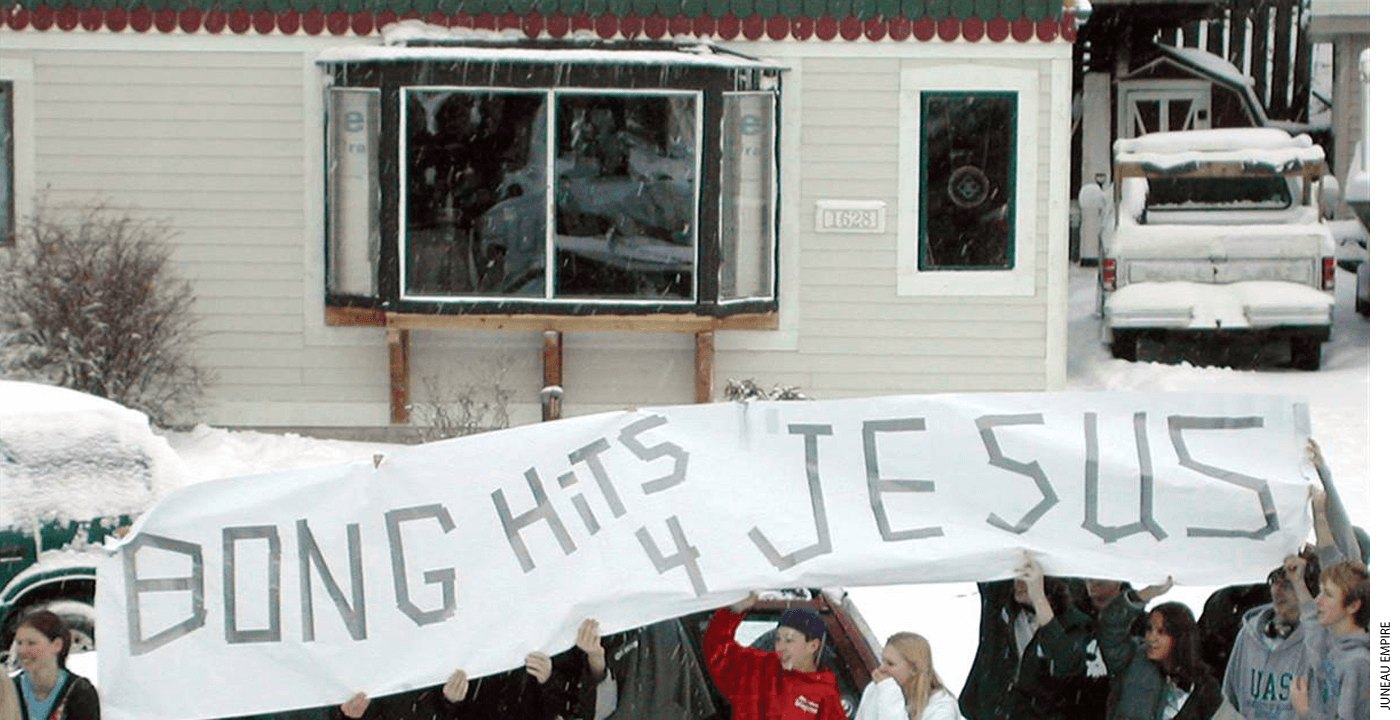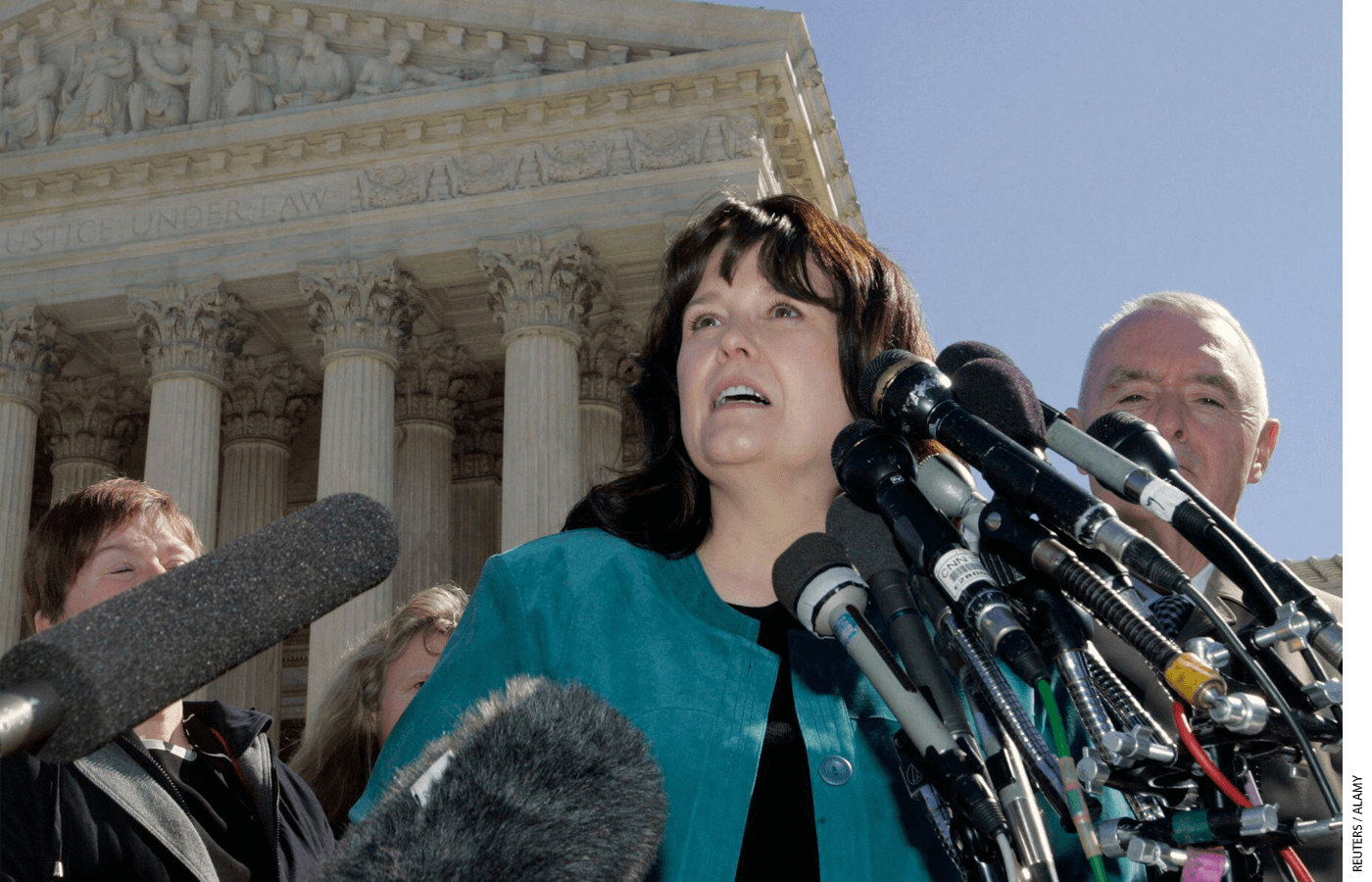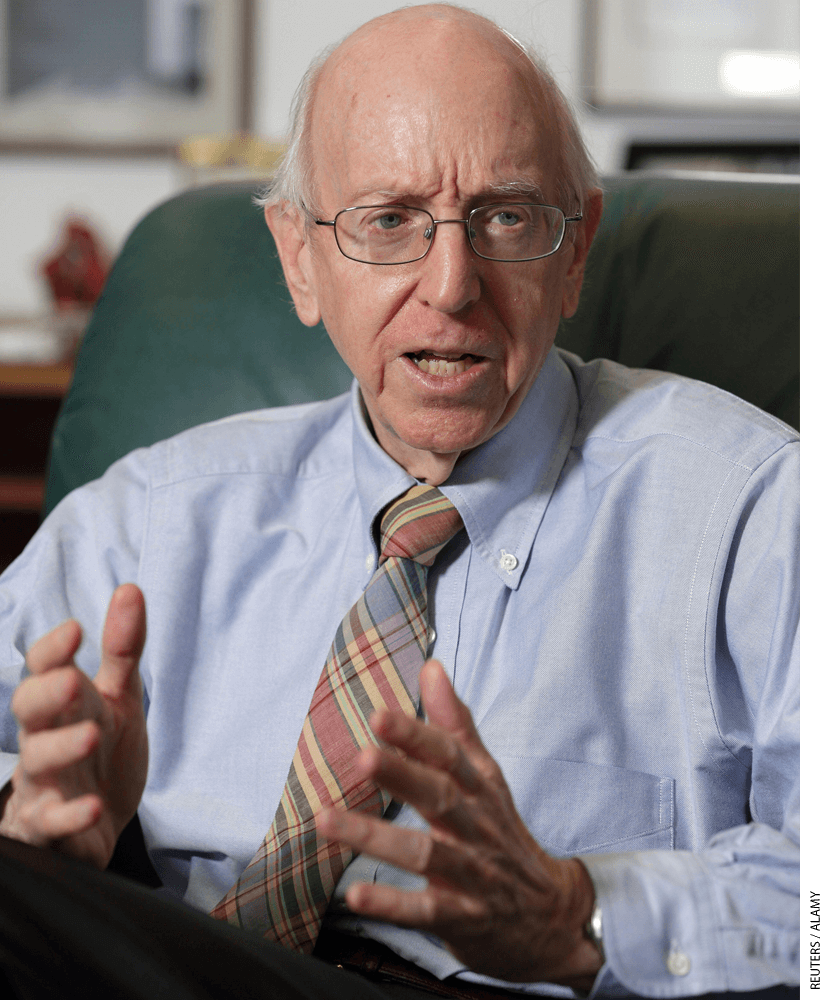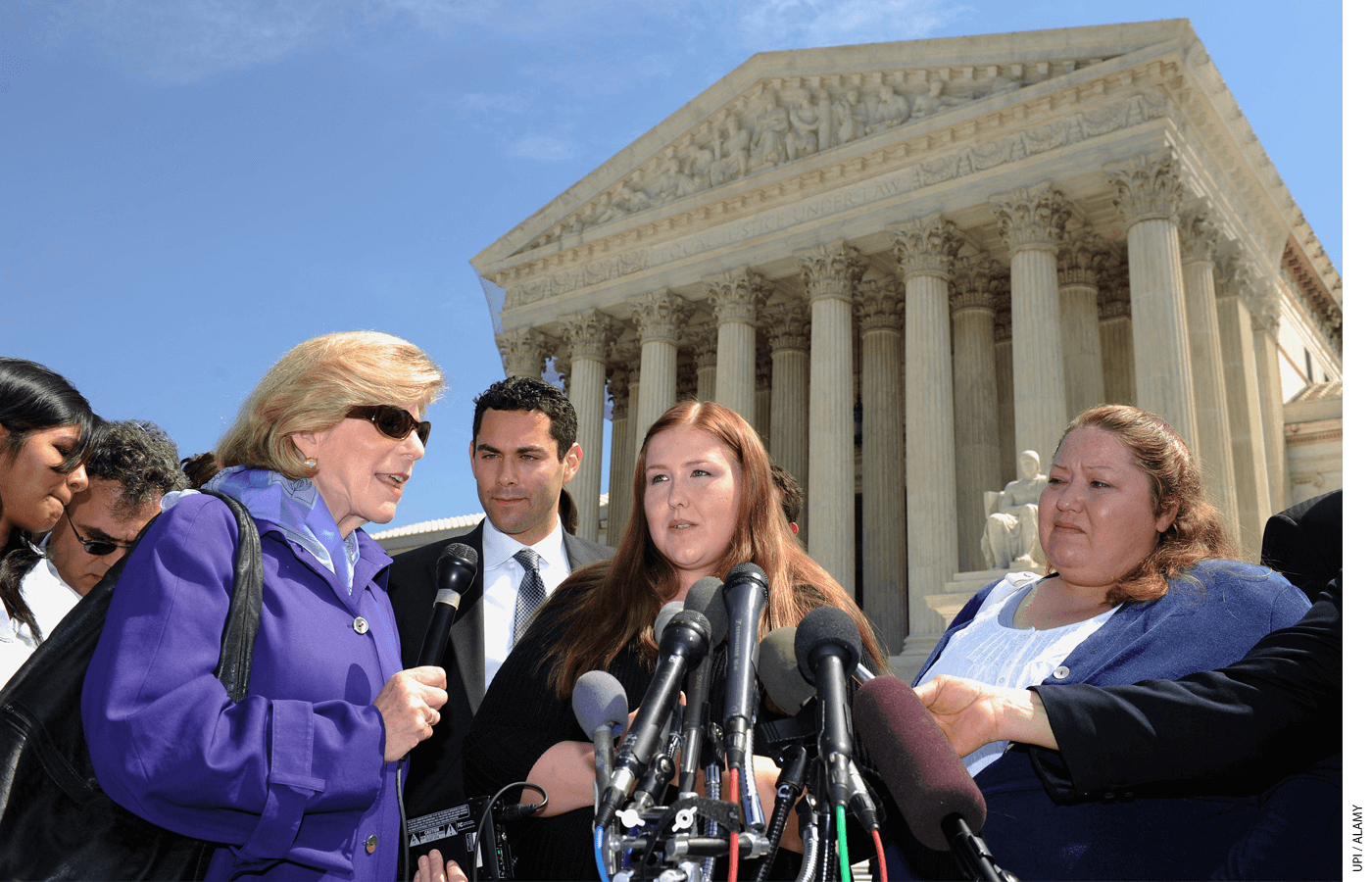
On the morning of March 19, 2007, I entered the grand courtroom of the U.S. Supreme Court and eagerly slipped into one of the worst seats in the house. My spot—far from center stage and with a view obstructed by enormous marble columns—was located in the section reserved for the justices’ law clerks so they could see, or at least hear, legal history being made. I had the privilege of serving that year as a clerk for Justice Stephen Breyer, assisting with tasks such as drafting written opinions and evaluating the merits of potential cases. I was particularly excited to hear the oral argument in that morning’s case because it involved a beguiling set of facts and marked the first time in nearly two decades that the Supreme Court would resolve a dispute involving students’ freedom of speech.
The case was formally titled Morse v. Frederick, but we law clerks called it by its nickname: BONG HiTS 4 JESUS. A 12th-grader in Juneau, Alaska, named Joseph Frederick had produced that odd, and oddly capitalized, slogan on a 14-foot-long banner that he unfurled across the street from his public school during a parade that teachers had permitted students to attend. When principal Deborah Morse saw the banner, she marched across the street, snatched the sign from Frederick’s hands, and later suspended him for 10 days, asserting that the sign ran afoul of the school’s rule against advocating the use of illegal drugs. So, as Frederick’s attorney, Douglas Mertz, strode to the lectern to make his argument before the court, I expected that the justices would immediately pelt him with a barrage of First Amendment questions: If the principal’s actions violated the First Amendment, might students around the nation start unfurling banners in the middle of algebra class? Should she and other educators have special authority to censor student speech regarding drugs, as everyone knows “bong hits” refers to marijuana? Given that Frederick was technically off campus when he displayed the banner, should the relatively restrictive judicial decisions governing student speech even apply to this case?

Mertz opened by observing: “This is a case about free speech. It is not a case about drugs.”
Before he could continue, though, Chief Justice John Roberts jumped in with a retort—one that has significance today not just for lawyers, but also for activists, politicians, and educators across the nation. “It’s a case about money,” Roberts chided. “Your client wants money from the principal personally for her actions in this case.” Mertz insisted that Frederick’s primary concern was vindicating students’ free expression, not any modest financial gain that might flow from a determination that the principal violated his client’s constitutional rights. Roberts further pressed Mertz on this monetary question: “[T]here’s a broader issue of whether principals and teachers around the country have to fear that they’re going to have to pay out of their personal pocket whenever they take actions . . . that they think are necessary to promote the school’s educational mission.”
Although Roberts never directly uttered the words “qualified immunity” during oral argument, his questioning of Mertz unmistakably invoked that doctrine. Qualified immunity is a legal principle that can insulate public employees from financial liability, even if the officials have been found to violate someone’s constitutional rights. In Frederick, the court found that principal Morse’s actions did not violate the Constitution, so the qualified-immunity question in that case largely faded in the written opinions.
Today, though, the once relatively arcane concept of qualified immunity has burst to the fore of public discussion, largely because of an increased focus on police misbehavior. Scholars and citizens alike have condemned the courts’ frequent use of qualified immunity to inoculate police officers from money damages in high-profile cases involving police violence. The exercise of qualified immunity, detractors emphasize, poses a nearly insurmountable obstacle for individuals and their families seeking financial compensation for police wrongdoing. Accordingly, a wide-ranging chorus of critics has demanded an end to qualified immunity.
Public discussion of qualified immunity most often examines the concept as applied to law enforcement, but other government officials can also invoke the protection. Indeed, judicial opinions involving teachers, principals, and schoolboard officials have played a central role in shaping qualified-immunity doctrine. A closer examination of these often overlooked school decisions deepens our understanding of the doctrine’s history and can help us contemplate its future. Viewing qualified immunity through the schooling prism suggests, as critics routinely assert in the policing context, that courts are too lenient in granting qualified immunity to educators. But the schooling prism also offers potent arguments against the wholesale elimination of qualified immunity for educators, regardless of whether the protection is eradicated for police officers.

When Does Qualified Immunity Apply?
The Supreme Court introduced the qualified-immunity doctrine in a case involving police officers in the late 1960s. In that case, police officers arrested a group of civil-rights protestors in Mississippi, citing a state anti-loitering law. The Supreme Court later deemed the statute unconstitutional, but it also determined the officers should not be held liable for enforcing a law they presumed valid. Although this case centered on police officers, it did not take long for the court to make clear that other government employees could avail themselves of the defense. In 1975, the court issued an opinion formally granting qualified immunity to educators in Wood v. Strickland, a momentous decision that arose from a delicious set of facts. Peggy Strickland, Virginia Crain, and Jo Wahl—three 10th-grade students at a small public high school in Arkansas—were tasked with providing refreshments at a mother-daughter event for the Future Homemakers of America club. The girls decided to purchase some Right Time malt liquor to spike the punch for the future homemakers and their mothers. The students added such a miniscule amount of malt liquor to the punch, however, that the resulting concoction neither tasted of alcohol nor could have intoxicated even the thirstiest eventgoer. Still, word of the stunt eventually trickled out, and the school board suspended the offending students for the remainder of the semester. A federal appellate court found that the suspensions violated the Fourteenth Amendment’s Due Process Clause.

The case made its way to the Supreme Court, which determined that schoolboard officials could in some instances avail themselves of qualified immunity. Writing for the court, Justice Byron White held that an educator could not be found liable for financial damages unless “he knew or reasonably should have known that the action he took . . . would violate the constitutional rights of the student affected, or if he took the action with the malicious intention to cause a deprivation of constitutional rights . . . to the student.” White continued, in language that would loom large over time, that damages would be assessed only if the educator acted with “such disregard of the student’s clearly established constitutional rights that his action cannot reasonably be characterized as being in good faith.”
Over time, the court abandoned Strickland’s subjective standard requiring jurists to decide whether a defendant had acted with good faith or, instead, “malicious intention.” But key phrases from Strickland have endured. The modern era’s leading case involving qualified immunity—Harlow v. Fitzgerald (1982)—unmistakably built upon the language introduced in Strickland, as Harlow instructs that plaintiffs cannot overcome qualified immunity unless they demonstrate that government officials “violate[d] clearly established . . . constitutional rights.” Since 1982, the Supreme Court has offered varying formulations for determining who may successfully invoke qualified immunity. In perhaps the broadest definition, the court in 1986 stated that qualified immunity shielded “all [government officials] but the plainly incompetent” from liability.
Yet today, the court’s basic test in deciding whether to apply the doctrine continues to be: did the government official in question transgress the Constitution in a way that had been “clearly established” by prior judicial decisions? If precedents have not clearly established the constitutional right in question, then government officials can successfully invoke qualified immunity, even if the court determines that their conduct violated the Constitution. In practice, courts typically require the plaintiff to identify binding precedents featuring government officials who have been found to violate the Constitution in a manner that is almost indistinguishable from the plaintiff’s own conditions.
This notion—that plaintiffs must present identical factual scenarios from past case law to demonstrate that an offense violates a “clearly established” right—is profoundly flawed. In 1990, Judge Richard A. Posner, perhaps the most celebrated legal mind of his generation, pressed this point memorably:
It begins to seem as if to survive a motion to dismiss a suit on grounds of [qualified] immunity the plaintiff must be able to point to a previous case that differs only trivially from his case. But this cannot be right. The easiest cases don’t even arise. There has never been a . . . case accusing welfare officials of selling foster children into slavery; it does not follow that if such a case arose, the officials would be immune from damages liability because no previous case had found liability in those circumstances.
Although jurists sometimes quote Judge Posner’s language, they too seldom embrace his logic.
Too Much Qualified Immunity?

Indeed, the judiciary has been excessively willing to grant immunity to educators, even in the face of heinous conduct that, properly understood, contravenes clearly established law. In one notorious decision from 1997, a federal appellate court afforded immunity to school officials who strip-searched two 2nd-grade girls in Talladega, Alabama. The search occurred in an (ultimately futile) effort to locate seven dollars that had supposedly gone missing from a teacher’s purse. In 1985, long before these odious events transpired, the Supreme Court articulated the governing standard for determining when educators violate the Fourth Amendment’s prohibition on unreasonable searches in a case titled New Jersey v. T.L.O. Student searches complied with the Fourth Amendment, the court found in T.L.O., only “when the measures adopted are reasonably related to the objectives of the search and not excessively intrusive in light of the age and sex of the student and the nature of the infraction.” The Talladega misadventure would plainly seem to fail this test, as requiring students to remove their undergarments is intensely invasive and the alleged infraction was trifling. Nevertheless, in Jenkins v. Talladega City Board of Education, the federal court deemed T.L.O.’s “broadly-worded phrases” as providing insufficiently “detailed guidance” to notify educators that they could not demand their young charges to expose their naked bodies in an attempt to recover a paltry sum of stolen money. Other federal appellate courts have also permitted educators to use qualified immunity to shield themselves in lawsuits arising from their, at best, wrongheaded strip searches of pupils.
The Supreme Court has also too readily invoked qualified immunity in education law cases. One example is the 2009 case Safford Unified School District v. Redding. The case arose after school officials in a tiny Arizona town subjected an 8th-grade honors student, Savana Redding, to a strip search for contraband. Redding was suspected of possessing nothing more potent than prescription-strength ibuprofen tablets, a substance banned by the school’s zero-tolerance drug policy. No one ever suggested that Redding had secreted painkillers in her underwear, but when a backpack search turned up nothing, two school officials instructed Redding to remove her clothing and to shift her undergarments in ways that exposed her breasts and pelvic area. This humiliating search failed to locate ibuprofen—or any other contraband. The Supreme Court ruled that the strip search had violated Redding’s Fourth Amendment rights because the substance in question was neither particularly potent nor likely to be located in her undergarments. Yet the court also found that Safford’s school officials had not violated clearly established law and were therefore entitled to qualified immunity. In a powerful dissent, Justice John Paul Stevens lambasted the court’s immunity holding, writing, “This is, in essence, a case in which clearly established law meets clearly outrageous conduct.”
Questioning Qualified Immunity
Although the Supreme Court introduced the concept of qualified immunity more than five decades ago, some justices—from across the ideological spectrum—have recently begun questioning its continued validity. Justice Sonia Sotomayor, the court’s leading liberal, and the archconservative Justice Clarence Thomas have both written separate opinions challenging qualified immunity. Thus far, however, Sotomayor and Thomas seem to have gained little traction with their colleagues on this issue. In June 2020, the court rejected nine separate petitions that would have teed up reconsideration of qualified immunity. Since only four of nine justices must agree to have the court address a legal question, it seems unlikely that advocates will soon be able to cobble together five votes to renounce qualified immunity. The court’s hesitation to cast aside such a longstanding practice reflects its extensive line of qualified-immunity opinions and its frequent adherence to the traditional principle of stare decisis—the Latin phrase meaning “to stand by things decided.”
It is possible, though, that Con-gress, rather than the Supreme Court, will act to alter the scope of qualified immunity, or perhaps even eliminate the practice. A legislative solution is possible, scholars hold, because qualified immunity stems from interpreting a congressional statute (42 U.S.C. § 1983)—not a constitutional provision. Prompted by the May 2020 killing of George Floyd at the hands of police in Minneapolis, Congress members have floated a few different proposals. The George Floyd Justice in Policing Act, introduced by Representative Karen Bass, Democrat of California, and recently passed by the House of Representatives, seeks to end qualified immunity for police officers. That measure would permit other government officials—including educators—to continue invoking the practice. But a broader proposal, titled the Ending Qualified Immunity Act, would eradicate the defense for all government officials. That sweeping proposal, introduced in June 2020, found backers in both the House of Representatives and the Senate, including Elizabeth Warren of Massachusetts and Bernie Sanders of Vermont, who were both then running for the Democratic presidential nomination. While political gridlock makes it extremely difficult to enact legislation in the modern era, it seems probable that Congress will entertain renewed calls for addressing qualified immunity at some point during the Biden administration. Lawmakers proposing such legislation would do well to consider whether they aim to curb the defense only for law enforcement officers or for all government officials, who include not just educators, but a wide range of civil servants.

Retaining Protection for Educators?
Even if qualified immunity is jettisoned for police officers, should the doctrine still apply to other public officials? Proponents of abolishing qualified immunity for all officials should consider three main arguments that could be marshaled for retaining the practice in schools. First, unlike the work of police officers, the primary responsibilities of teachers are not inherently imbued with legality and constitutionality. Honoring citizens’ Fourth and Fifth Amendment rights is central to a police officer’s work, or at least it should be. While constitutional issues certainly arise in the school environment, many teachers go their entire careers without confronting firsthand a close question involving students’ rights. Stephen Breyer voiced a version of this argument in his Frederick concurring opinion, where he advocated resolving the case solely by granting principal Morse qualified immunity and avoiding the First Amendment question entirely. “Teachers are neither lawyers nor police officers,” Breyer reasoned, “and the law should not demand that they fully understand the intricacies of our . . . jurisprudence.” My own practical experience corroborates Breyer’s argument. Following my college graduation, when I was working toward a master’s degree in teaching, I student-taught civics and U.S. history at a high school in Durham, North Carolina. I heard many topics broached in discussions among teachers that year, but I cannot recall a single conversation addressing students’ constitutional rights, and I am confident that the term “qualified immunity” was never bruited about the faculty lounge.
The second argument for retaining some qualified-immunity protection for educators is that teachers are far less likely than police officers to use lethal force against people in the course of executing their responsibilities. Even in the states that still permit educators to inflict corporal punishment on students, those actions are mild compared to the harms that can all too easily flow from police officers using their weapons. The teacher’s paddle is, in other words, a far cry from the officer’s gun.
Third, there are significant differences between the constitutional case law pertaining to police offers and the law that applies to educators. The judiciary has produced an ample body of constitutional opinions governing police conduct, resulting in a well-developed legal field, while the court opinions on students’ constitutional rights are quite sparse. This disparity in the number of precedents means that educators are much more likely than police officers to encounter legally novel situations in which the law contains legitimate ambiguity even for people who know the existing doctrine well. Affording educators the possibility of qualified immunity may thus be desirable in the face of comparatively widespread uncertainty regarding the constitutionality of their actions.
Yet at least one prominent argument advanced for reflexively conferring qualified immunity on educators should draw skepticism. Chief Justice Roberts’s emotional plea during oral argument in Frederick conjured up the deeply sympathetic image of principal Morse having to shoulder the expense of financial damages on her own. That image deserves little credence. An Alaskan statute dating back to the 1970s requires school boards throughout the state to indemnify school officials against legal costs incurred in the course of their official duties. Educator indemnification statutes like Alaska’s appear across the United States, meaning that school officials are seldom required to pay damages in the manner that Roberts posited. School districts typically purchase insurance policies for coverage in such instances. Of course, if enough school districts are forced to pay significant financial damages growing out of student lawsuits, their insurance premiums will eventually increase, and the additional charges will be drawn from already strapped education budgets. While that dynamic might be lamentable, it is far less disconcerting than individual teachers rifling through their couch cushions to scrounge up the required money themselves.
This article has largely treated the school setting and the police setting as distinct, but it is important to remember that uniformed police officers do appear in many public schools as “school resource officers,” or SROs. As long as the practice of qualified immunity continues, courts should be careful about permitting SROs to cloak themselves too easily with that doctrine. A few years ago, an SRO in New Mexico arrested a middle-school student for interrupting physical-education class by repeatedly belching. Rather than informing the belcher’s parents or giving him a stern lecture, the SRO handcuffed the 7th-grader and drove him in a police cruiser to juvenile detention. In 2016, Neil Gorsuch, then a federal appeals court judge, wrote an opinion that would have denied the SRO qualified immunity: “I would have thought [the existing judicial decisions] sufficient to alert any reasonable officer . . . that arresting a now compliant class clown for burping was going a step too far.” Unfortunately, though, Gorsuch’s comments arrived in a dissent, as his colleagues on the appellate court disagreed and granted the SRO’s invocation of qualified immunity. Let us hope that now-Justice Gorsuch enjoys better luck convincing his new colleagues at the Supreme Court to rein in the distressingly frequent excesses of qualified immunity.
Justin Driver is a professor at Yale Law School and the author of The Schoolhouse Gate: Public Education, the Supreme Court, and the Battle for the American Mind.
The post Schooling Qualified Immunity appeared first on Education Next.
By: Justin Driver
Title: Schooling Qualified Immunity
Sourced From: www.educationnext.org/schooling-qualified-immunity-should-educators-be-shielded-from-civil-liability/
Published Date: Tue, 23 Mar 2021 10:00:01 +0000
News…. browse around here
No comments:
Post a Comment